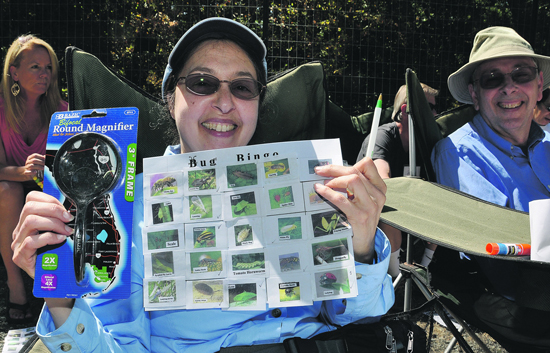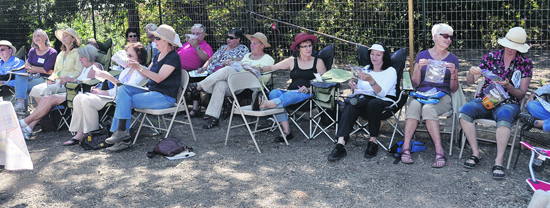 | | | Linda Myers of Lafayette shows off magnifier after winning Bug Bingo game; husband Philip (right) came in second Photo Andy Scheck
| | | | | | Bug Bingo? Yes, Bug Bingo - also called, "How to learn your bugs and how to live with them in your garden" - was the new trendy game at the Lafayette Community Garden Saturday, July 14 facilitated by landscape designer and gardener Susanne Frey in the outdoor learning classroom across from the Lafayette Reservoir. About 15 adults and a few children came to find natural ways to manage pests and left with a better understanding of the natural processes that the savvy gardener can foster.
 Once participants learned to identify the Mealy Bug, the Thrip, the Lacewing and the Katydid, the question was: Which ones are good, bad or ugly?
Once participants learned to identify the Mealy Bug, the Thrip, the Lacewing and the Katydid, the question was: Which ones are good, bad or ugly?
 "The good guys are the predators," said Frey. "They eat the bad guys, and they will come only if prey is there, so you need a little bit of prey to attract the predators."
"The good guys are the predators," said Frey. "They eat the bad guys, and they will come only if prey is there, so you need a little bit of prey to attract the predators."
 Aphids and Tomato Hornworms were easy to identify as "bad," while Ladybugs and Honey Bees are known to be "good." The Syrphid Fly Larva, however, which looks like a green caterpillar ready to eat anything plant-like, could easily be labeled as bad, when in fact it gives birth to the Syrphid fly, a nice little guy that loves to eat aphids; in fact, even the larvae eat aphids, so don't squish it!
Aphids and Tomato Hornworms were easy to identify as "bad," while Ladybugs and Honey Bees are known to be "good." The Syrphid Fly Larva, however, which looks like a green caterpillar ready to eat anything plant-like, could easily be labeled as bad, when in fact it gives birth to the Syrphid fly, a nice little guy that loves to eat aphids; in fact, even the larvae eat aphids, so don't squish it!
 Frey put the always slightly disturbing Praying Mantis, along with the Pillbug (roly-poly) and the Yellow Jacket, in the "ambiguous" category. "Praying Mantises will eat anything, good or bad," she said.
Frey put the always slightly disturbing Praying Mantis, along with the Pillbug (roly-poly) and the Yellow Jacket, in the "ambiguous" category. "Praying Mantises will eat anything, good or bad," she said.
 "The purpose of the class is to help you identify the good and bad most common bugs so you don't get rid of the good ones and you let nature remove the pests for you," she said. One participant said that she had a plant covered in Soldier Beetles. "Let them be," responded Frey. "They won't damage your plants and will control other nasty population groups."
"The purpose of the class is to help you identify the good and bad most common bugs so you don't get rid of the good ones and you let nature remove the pests for you," she said. One participant said that she had a plant covered in Soldier Beetles. "Let them be," responded Frey. "They won't damage your plants and will control other nasty population groups."
 Frey circulated sealed bags containing damaged plants and the culprit live bugs throughout the class. "Some pests are suckers and others are chewers," she said. "When you see damage, you have to determine the cause, and everything you see can be a clue."
Frey circulated sealed bags containing damaged plants and the culprit live bugs throughout the class. "Some pests are suckers and others are chewers," she said. "When you see damage, you have to determine the cause, and everything you see can be a clue."
 In one of the bags, leaves from a rose plant were covered in small black spots. "The culprit in the bag, a spotted cucumber beetle, is a sucker," said Frey. "It will destroy leaves and what's worse, it will leave the plant more vulnerable to fungi and further diseases."
In one of the bags, leaves from a rose plant were covered in small black spots. "The culprit in the bag, a spotted cucumber beetle, is a sucker," said Frey. "It will destroy leaves and what's worse, it will leave the plant more vulnerable to fungi and further diseases."
 Frey added that it is often difficult to spot these pests. "They come out at night to avoid predators," she explained. "The best way to find them for identification is very early in the morning, or at night, going out with a flashlight."
Frey added that it is often difficult to spot these pests. "They come out at night to avoid predators," she explained. "The best way to find them for identification is very early in the morning, or at night, going out with a flashlight."
 Once they are found and identified, Frey does not recommend any type of insecticide. "Insecticides are the last resort when nothing else has worked because these products kill everything, the bad and the good."
Once they are found and identified, Frey does not recommend any type of insecticide. "Insecticides are the last resort when nothing else has worked because these products kill everything, the bad and the good."
 The best way to avoid an infestation, she explained, is to have healthy plants. "The plants that are attacked are the weak, old or stressed ones," she said. Fostering good gardening practices is the best way to keep the garden pest-free.
The best way to avoid an infestation, she explained, is to have healthy plants. "The plants that are attacked are the weak, old or stressed ones," she said. Fostering good gardening practices is the best way to keep the garden pest-free.
 "Remove all the decaying and dead material from your garden," she said. "Maximize the air circulation, group together plants with the same water need and don't over or under-water. Mix the plants and never underestimate the power of mulch."
"Remove all the decaying and dead material from your garden," she said. "Maximize the air circulation, group together plants with the same water need and don't over or under-water. Mix the plants and never underestimate the power of mulch."
 According to Frey, mulching will provide an efficient barrier from nesting bugs and keep the plants in better shape. She also recommended amending the soil rather than fertilizing plants. "Plants will find what they need in the soil. If you fertilize you will put the plant on steroids; there will be results, but the plant will be stressed and therefore vulnerable to bugs." She also recommended a water feature in the garden to attract beneficial insects and birds.
According to Frey, mulching will provide an efficient barrier from nesting bugs and keep the plants in better shape. She also recommended amending the soil rather than fertilizing plants. "Plants will find what they need in the soil. If you fertilize you will put the plant on steroids; there will be results, but the plant will be stressed and therefore vulnerable to bugs." She also recommended a water feature in the garden to attract beneficial insects and birds.
 Janet Thomas, one of the garden's founders, participated in the class. "This is our second free class and we are very happy with the outcome," she said. All the participants left with their Bug Bingo cards with smiley stickers applied to the pictures of the good bugs - a perfect reminder for a refrigerator door.
Janet Thomas, one of the garden's founders, participated in the class. "This is our second free class and we are very happy with the outcome," she said. All the participants left with their Bug Bingo cards with smiley stickers applied to the pictures of the good bugs - a perfect reminder for a refrigerator door.
 The next two classes are California Edibles and What Native Americans Ate by Kim Curiel from 3 to 5 p.m. August 4 and Winter Gardens with Nanette Heffernan at the same time on September 29. For more information, visit lafayettecommunitygarden.org.
The next two classes are California Edibles and What Native Americans Ate by Kim Curiel from 3 to 5 p.m. August 4 and Winter Gardens with Nanette Heffernan at the same time on September 29. For more information, visit lafayettecommunitygarden.org.

|

